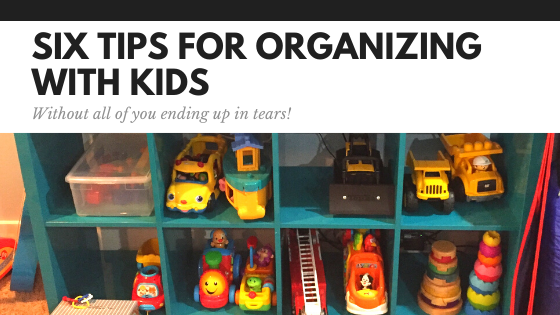- They have the attention span of a gnat.
- It can cause a lot of fights.
- They don’t want to get rid of ANYTHING.
- Tears, tears, tears.
Despite all that, there are several reasons to include your kids in your organizing project. Organization is a life skill and it’s one of the many things to teach your kids. She’ll also start to appreciate the work it takes to maintain items in a home, and, perhaps more importantly, she’ll start to learn what organizing techniques work for her on a personal level.
Like most things with kids, this takes a lot of work and patience. It’s not easy. But it’s worth it. If it’s something you want to start working on with your kids, here are 6 tips and techniques to try.
1. Define your goals and let the rest go.
Before kicking off your project, think about your goals. Is it for your kid to have a room that you like? Or is it to have a kid who takes ownership of his items? A kid that can put her clothes away on her own? A kid that will eventually be able to maintain his spaces? When you get to the inevitable frustrating moments, go back to your goals. Do you need to “win” that battle or is it time to let it go?
You’ll have to bite your tongue at many points in the process. Your kid will likely want to keep items that make no sense to you and want to get rid of items that you think she should definitely keep. Let it go! Don’t try to convince her to keep items she wants to purge. You can always store them in another part of the home if you aren’t ready to let them go (that’s a whole other problem to solve!).
2. Ask for his opinion

Asking for your kid’s opinion at as many decision-making points as possible let her take ownership of the project. Does it really matter where or how her clothes are stored? If not, let her pick. The more involved she is the better. If she complains about something in her room, ask her what she wants to do about it. Helping kids see the big picture and understand the joy of an organized space is difficult, but once it “clicks” they can better manage their items all on their own.
3. Explain where purged items are going
Just like adults, it’s easier to get rid of items if you know these items that were once loved will go to another home where they will be loved. Depending on the age of your child, this can be explained as, “These toys are going to go to another kid that doesn’t have these toys.” or “Another little kid will really enjoy playing with this toy, just like you did.”
4. Use the 2-In 1-Out Decluttering Method
Let’s pretend stuffed animals have taken over your kid’s room and it’s time to declutter. The 2-In 1-Out Method would look something like this:
- Take three stuffed animals and ask your kid to pick one to donate.
- After that the other two go into the “keep” pile.
- Pick another three stuffed animals and repeat.
Trades can be made if a selection of three contains all keepers. It’s not about being exact, but making progress towards the goal of removing items from your home. You will be helping him to understand the process of trimming his collection and but giving them the freedom to choose what stays and goes.
5. Work in small time blocks
Kids can only stand home organizing for so long – how long depends on about a million factors…their age, did they just eat, are they tired, is there a new toy

that just arrived that they really want to play with…the list goes on. Figure out what your kid can handle, set a timer, and when it goes off, release her to go play. You may need to start with only 5 minutes and then slowly increase to more time as she gets used to it. However this doesn’t mean you have to stop working after 5 minutes. Keep working in other areas. Try pulling her back for small questions about what to do with items.
6. Reward at end
Even more than adults kids are motivated by rewards or prizes at the end of doing something they don’t want to. Decide on what success looks like and pick a reward to help them stay motivated. Make sure the goal is reasonable and achievable for your kid, such as purging one bin of LEGOs (not organizing the whole playroom). A few tips for rewarding their work:
- Remind them of the reward as you work through the project.
- Try a disposable goal as a reward (i.e. ice cream!) rather than more toys.
- Give yourself a reward too! ☺
As always, organizing is not one-size fits all, so just pick what resonates with you…and your kid! But if the thought of home organizing with your kid gives you a headache, contact us! We help all ages through the organizing process for sustainable solutions in the Houston area.

